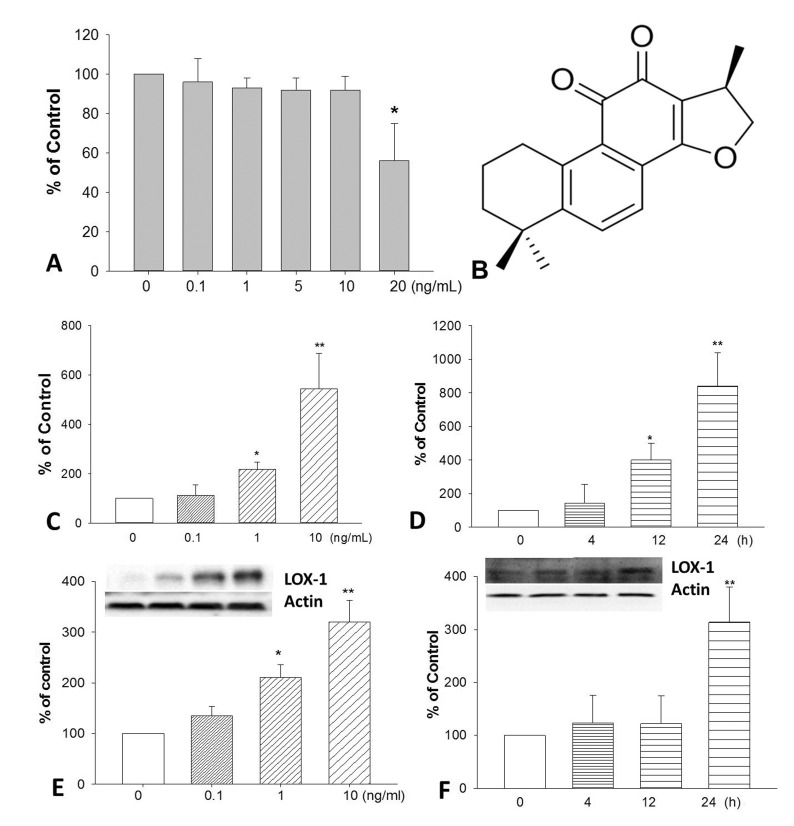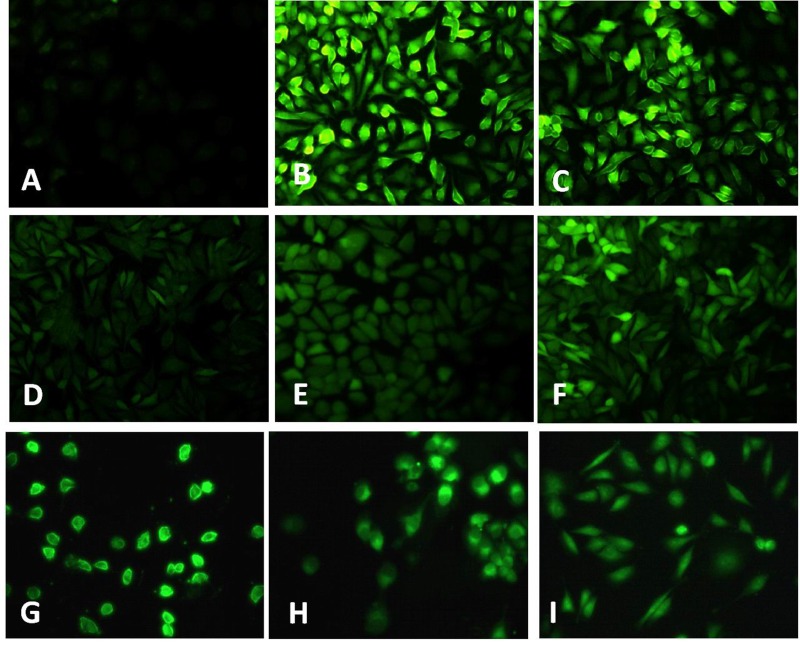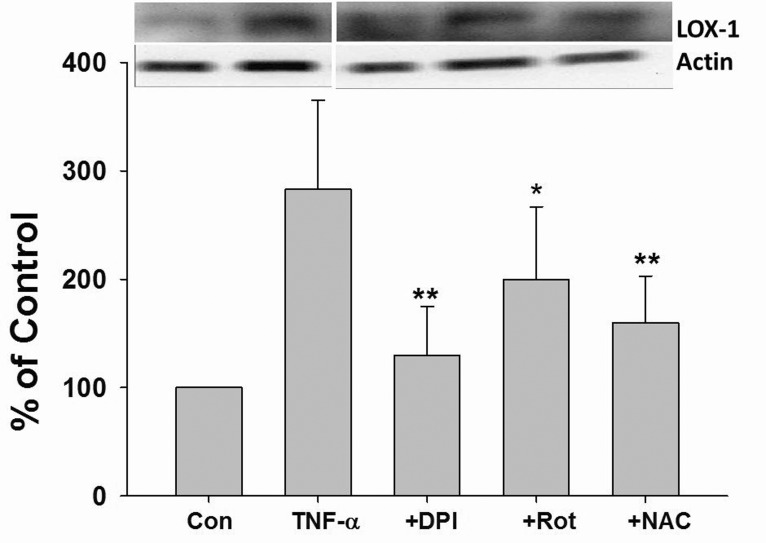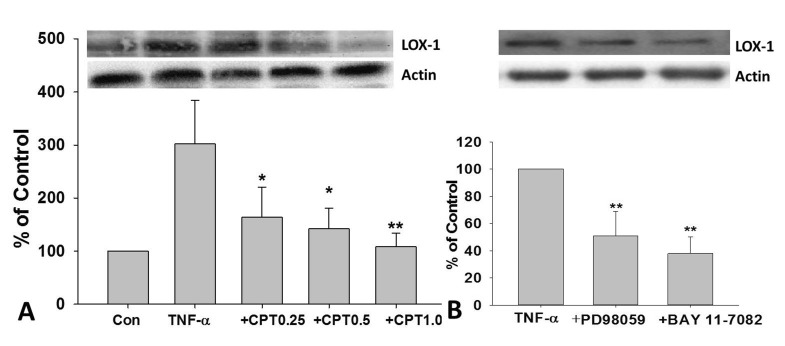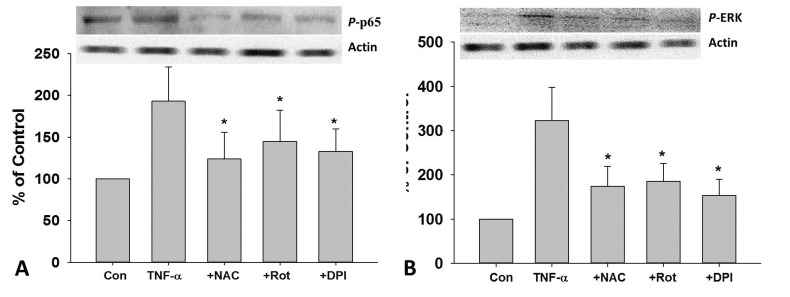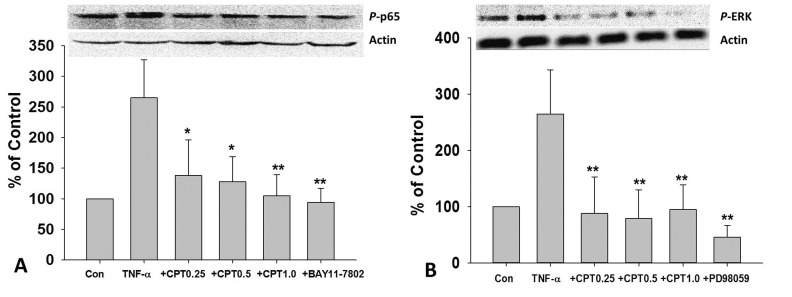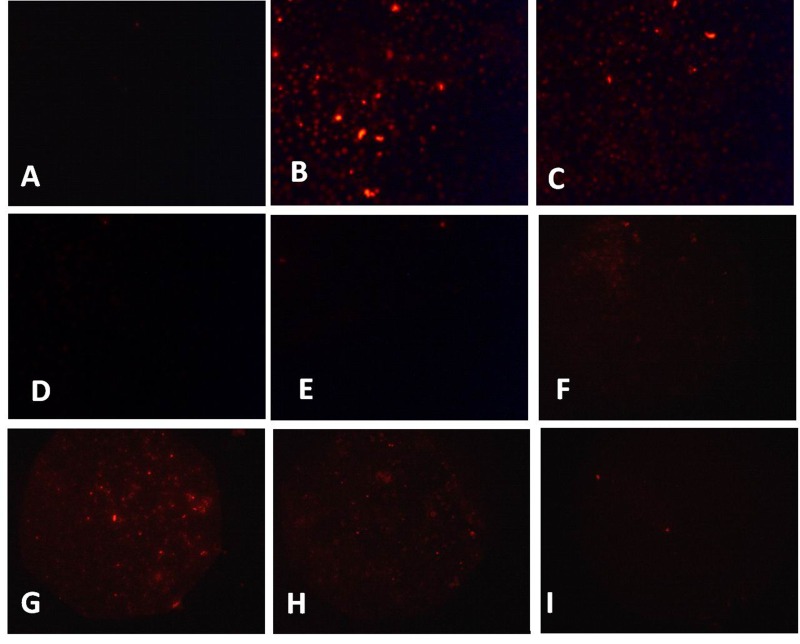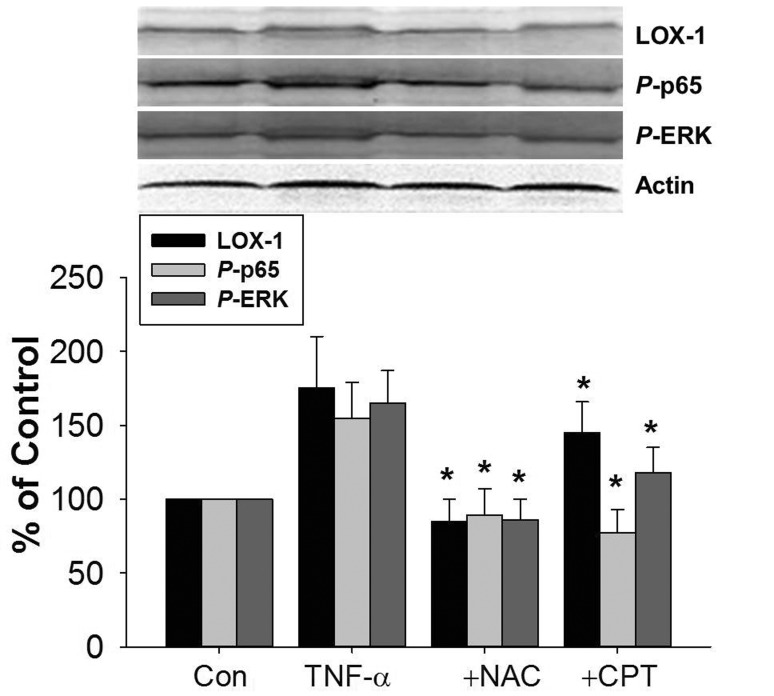Korean J Physiol Pharmacol.
2016 Jul;20(4):347-355. 10.4196/kjpp.2016.20.4.347.
Cryptotanshinone inhibits TNF-α-induced LOX-1 expression by suppressing reactive oxygen species (ROS) formation in endothelial cells
- Affiliations
-
- 1Department of Pharmacology and the Key Laboratory of Basic Pharmacology of Guizhou Province, Zunyi Medical College, Guizhou 563000, China. shijs@zmc.edu.cn
- 2State Key Laboratory of Quality Research in Chinese Medicine, Institute of Chinese Medical Sciences, University of Macau 999078, Macao, China. xpchen@umac.mo
- KMID: 2371052
- DOI: http://doi.org/10.4196/kjpp.2016.20.4.347
Abstract
- Cryptotanshinone (CPT) is a natural compound isolated from traditional Chinese medicine Salvia miltiorrhiza Bunge. In the present study, the regulatory effect and potential mechanisms of CPT on tumor necrosis factor alpha (TNF-α) induced lectin-like receptor for oxidized low density lipoprotein (LOX-1) were investigated. Human umbilical vein endothelial cells (HUVECs) were cultured and the effect of TNF-α on LOX-1 expression at mRNA and protein levels was determined by Real-time PCR and Western blotting respectively. The formation of intracellular ROS was determined with fluorescence probe CM-DCFH2-DA. The endothelial ox-LDL uptake was evaluated with DiI-ox-LDL. The effect of CPT on LOX-1 expression was also evaluated with SD rats. TNF-α induced LOX-1 expression in a dose- and time-dependent manner in endothelial cells. TNF-α induced ROS formation, phosphorylation of NF-κB p65 and ERK, and LOX-1 expression, which were suppressed by rotenone, DPI, NAC, and CPT. NF-κB inhibitor BAY11-7082 and ERK inhibitor PD98059 inhibited TNF-α-induced LOX-1 expression. CPT and NAC suppressed TNF-α-induced LOX-1 expression and phosphorylation of NF-κB p65 and ERK in rat aorta. These data suggested that TNF-α induced LOX-1 expression via ROS activated NF-κB/ERK pathway, which could be inhibited by CPT. This study provides new insights for the anti-atherosclerotic effect of CPT.
MeSH Terms
-
Animals
Aorta
Blotting, Western
Endothelial Cells*
Fluorescence
Human Umbilical Vein Endothelial Cells
Lipoproteins
Medicine, Chinese Traditional
Phosphorylation
Rats
Reactive Oxygen Species*
Real-Time Polymerase Chain Reaction
RNA, Messenger
Rotenone
Salvia miltiorrhiza
Tumor Necrosis Factor-alpha
Lipoproteins
RNA, Messenger
Reactive Oxygen Species
Rotenone
Tumor Necrosis Factor-alpha
Figure
Cited by 1 articles
-
Lactobacillus casei strain C1 attenuates vascular changes in spontaneously hypertensive rats
Wei Boon Yap, Faisal Malau Ahmad, Yi Cheng Lim, Satirah Zainalabidin
Korean J Physiol Pharmacol. 2016;20(6):621-628. doi: 10.4196/kjpp.2016.20.6.621.
Reference
-
1. Yagi A, Fujimoto K, Tanonaka K, Hirai K, Takeo S. Possible active components of tan-shen (Salvia miltiorrhiza) for protection of the myocardium against ischemia-induced derangements. Planta Med. 1989; 55:51–54. PMID: 2717690.2. Ma S, Yang D, Wang K, Tang B, Li D, Yang Y. Cryptotanshinone attenuates isoprenaline-induced cardiac fibrosis in mice associated with upregulation and activation of matrix metalloproteinase-2. Mol Med Rep. 2012; 6:145–150. PMID: 22505122.3. Jin HJ, Xie XL, Ye JM, Li CG. TanshinoneIIA and cryptotanshinone protect against hypoxia-induced mitochondrial apoptosis in H9c2 cells. PLoS One. 2013; 8:e51720. PMID: 23341883.
Article4. Suh SJ, Jin UH, Choi HJ, Chang HW, Son JK, Lee SH, Jeon SJ, Son KH, Chang YC, Lee YC, Kim CH. Cryptotanshinone from Salvia miltiorrhiza BUNGE has an inhibitory effect on TNF-alpha-induced matrix metalloproteinase-9 production and HASMC migration via down-regulated NF-kappaB and AP-1. Biochem Pharmacol. 2006; 72:1680–1689. PMID: 16999937.5. Zhou Z, Wang SQ, Liu Y, Miao AD. Cryptotanshinone inhibits endothelin-1 expression and stimulates nitric oxide production in human vascular endothelial cells. Biochim Biophys Acta. 2006; 1760:1–9. PMID: 16289876.
Article6. Jin YC, Kim CW, Kim YM, Nizamutdinova IT, Ha YM, Kim HJ, Seo HG, Son KH, Jeon SJ, Kang SS, Kim YS, Kam SC, Lee JH, Chang KC. Cryptotanshinone, a lipophilic compound of Salvia miltiorrriza root, inhibits TNF-alpha-induced expression of adhesion molecules in HUVEC and attenuates rat myocardial ischemia/reperfusion injury in vivo. Eur J Pharmacol. 2009; 614:91–97. PMID: 19401198.7. Ang KP, Tan HK, Selvaraja M, Kadir AA, Somchit MN, Akim AM, Zakaria ZA, Ahmad Z. Cryptotanshinone attenuates in vitro oxLDL-induced pre-lesional atherosclerotic events. Planta Med. 2011; 77:1782–1787. PMID: 21614753.8. Sawamura T, Kume N, Aoyama T, Moriwaki H, Hoshikawa H, Aiba Y, Tanaka T, Miwa S, Katsura Y, Kita T, Masaki T. An endothelial receptor for oxidized low-density lipoprotein. Nature. 1997; 386:73–77. PMID: 9052782.
Article9. Chen XP, Zhang TT, Du GH. Lectin-like oxidized low-density lipoprotein receptor-1, a new promising target for the therapy of atherosclerosis? Cardiovasc Drug Rev. 2007; 25:146–161. PMID: 17614937.
Article10. Renier G. Lectin-like oxidized low-density lipoprotein receptor-1 (LOX-1), a relevant target for diabetic vasculopathy? Cardiovasc Hematol Disord Drug Targets. 2008; 8:203–211. PMID: 18781933.
Article11. Ulrich-Merzenich G, Zeitler H. The lectin-like oxidized low-density lipoprotein receptor-1 as therapeutic target for atherosclerosis, inflammatory conditions and longevity. Expert Opin Ther Targets. 2013; 17:905–919. PMID: 23738516.
Article12. Chen XP, DU GH. Lectin-like oxidized low-density lipoprotein receptor-1: protein, ligands, expression and pathophysiological significance. Chin Med J (Engl). 2007; 120:421–426. PMID: 17376315.
Article13. Kume N, Murase T, Moriwaki H, Aoyama T, Sawamura T, Masaki T, Kita T. Inducible expression of lectin-like oxidized LDL receptor-1 in vascular endothelial cells. Circ Res. 1998; 83:322–327. PMID: 9710125.
Article14. Moriwaki H, Kume N, Kataoka H, Murase T, Nishi E, Sawamura T, Masaki T, Kita T. Expression of lectin-like oxidized low density lipoprotein receptor-1 in human and murine macrophages: upregulated expression by TNF-alpha. FEBS Lett. 1998; 440:29–32. PMID: 9862418.15. Kume N, Moriwaki H, Kataoka H, Minami M, Murase T, Sawamura T, Masaki T, Kita T. Inducible expression of LOX-1, a novel receptor for oxidized LDL, in macrophages and vascular smooth muscle cells. Ann N Y Acad Sci. 2000; 902:323–327. PMID: 10865857.
Article16. Chiba Y, Ogita T, Ando K, Fujita T. PPARgamma ligands inhibit TNF-alpha-induced LOX-1 expression in cultured endothelial cells. Biochem Biophys Res Commun. 2001; 286:541–546. PMID: 11511093.17. Shibata Y, Kume N, Arai H, Hayashida K, Inui-Hayashida A, Minami M, Mukai E, Toyohara M, Harauma A, Murayama T, Kita T, Hara S, Kamei K, Yokode M. Mulberry leaf aqueous fractions inhibit TNF-alpha-induced nuclear factor kappaB (NF-kappaB) activation and lectin-like oxidized LDL receptor-1 (LOX-1) expression in vascular endothelial cells. Atherosclerosis. 2007; 193:20–27. PMID: 17055514.18. Lee MJ, Lee HS, Park SD, Moon HI, Park WH. Leonurus sibiricus herb extract suppresses oxidative stress and ameliorates hypercholesterolemia in C57BL/6 mice and TNF-alpha induced expression of adhesion molecules and lectin-like oxidized LDL receptor-1 in human umbilical vein endothelial cells. Biosci Biotechnol Biochem. 2010; 74:279–284. PMID: 20139626.19. Song G, Tian H, Liu J, Zhang H, Sun X, Qin S. H2 inhibits TNF-α-induced lectin-like oxidized LDL receptor-1 expression by inhibiting nuclear factor κB activation in endothelial cells. Biotechnol Lett. 2011; 33:1715–1722. PMID: 21544615.
Article20. Yamagata K, Tusruta C, Ohtuski A, Tagami M. Docosahexaenoic acid decreases TNF-α-induced lectin-like oxidized low-density lipoprotein receptor-1 expression in THP-1 cells. Prostaglandins Leukot Essent Fatty Acids. 2014; 90:125–132. PMID: 24518001.
Article21. Chen X, Zhong Z, Xu Z, Chen L, Wang Y. No protective effect of curcumin on hydrogen peroxide-induced cytotoxicity in HepG2 cells. Pharmacol Rep. 2011; 63:724–732. PMID: 21857083.
Article22. Chen X, Zhong Z, Xu Z, Chen L, Wang Y. 2',7'-Dichlorodihydr ofluorescein as a fluorescent probe for reactive oxygen species measurement: Forty years of application and controversy. Free Radic Res. 2010; 44:587–604. PMID: 20370560.23. Zhang T, Huang Z, Dai Y, Chen X, Zhu P, Du G. The expression of recombinant human LOX-1 and identifying its mimic ligands by fluorescence polarization-based high throughput screening. J Biotechnol. 2006; 125:492–502. PMID: 16735073.
Article24. Chen X, Andresen BT, Hill M, Zhang J, Booth F, Zhang C. Role of reactive oxygen species in tumor necrosis factor-alpha induced endothelial dysfunction. Curr Hypertens Rev. 2008; 4:245–255. PMID: 20559453.
Article25. Zhang H, Park Y, Wu J, Chen Xp, Lee S, Yang J, Dellsperger KC, Zhang C. Role of TNF-alpha in vascular dysfunction. Clin Sci (Lond). 2009; 116:219–230. PMID: 19118493.26. Dunn S, Vohra RS, Murphy JE, Homer-Vanniasinkam S, Walker JH, Ponnambalam S. The lectin-like oxidized low-density-lipoprotein receptor: a pro-inflammatory factor in vascular disease. Biochem J. 2008; 409:349–355. PMID: 18092947.
Article27. Liang M, Zhang P, Fu J. Up-regulation of LOX-1 expression by TNF-alpha promotes trans-endothelial migration of MDA- MB-231 breast cancer cells. Cancer Lett. 2007; 258:31–37. PMID: 17868983.28. Chen X, Zhang H, McAfee S, Zhang C. The reciprocal relationship between adiponectin and LOX-1 in the regulation of endothelial dysfunction in ApoE knockout mice. Am J Physiol Heart Circ Physiol. 2010; 299:H605–H612. PMID: 20581092.
Article29. Nagase M, Ando K, Nagase T, Kaname S, Sawamura T, Fujita T. Redox-sensitive regulation of lox-1 gene expression in vascular endothelium. Biochem Biophys Res Commun. 2001; 281:720–725. PMID: 11237717.
Article30. Sun Y, Chen X. Ox-LDL-induced LOX-1 expression in vascular smooth muscle cells: role of reactive oxygen species. Fundam Clin Pharmacol. 2011; 25:572–579. PMID: 21077940.
Article31. Pirillo A, Reduzzi A, Ferri N, Kuhn H, Corsini A, Catapano AL. Upregulation of lectin-like oxidized low-density lipoprotein receptor-1 (LOX-1) by 15-lipoxygenase-modified LDL in endothelial cells. Atherosclerosis. 2011; 214:331–337. PMID: 21130457.
Article32. Li L, Sawamura T, Renier G. Glucose enhances endothelial LOX-1 expression: role for LOX-1 in glucose-induced human monocyte adhesion to endothelium. Diabetes. 2003; 52:1843–1850. PMID: 12829655.33. Fu R, Yan T, Wang Q, Guo Q, Yao H, Wu X, Li Y. Suppression of endothelial cell adhesion by XJP-1, a new phenolic compound derived from banana peel. Vascul Pharmacol. 2012; 57:105–112. PMID: 22609942.
Article34. Lee WY, Liu KW, Yeung JH. Reactive oxygen species-mediated kinase activation by dihydrotanshinone in tanshinones-induced apoptosis in HepG2 cells. Cancer Lett. 2009; 285:46–57. PMID: 19467570.
Article35. Chen W, Liu L, Luo Y, Odaka Y, Awate S, Zhou H, Shen T, Zheng S, Lu Y, Huang S. Cryptotanshinone activates p38/JNK and inhibits Erk1/2 leading to caspase-independent cell death in tumor cells. Cancer Prev Res (Phila). 2012; 5:778–787. PMID: 22490436.
Article36. Mukai E, Kume N, Hayashida K, Minami M, Yamada Y, Seino Y, Kita T. Heparin-binding EGF-like growth factor induces expression of lectin-like oxidized LDL receptor-1 in vascular smooth muscle cells. Atherosclerosis. 2004; 176:289–296. PMID: 15380451.
Article37. Li L, Sawamura T, Renier G. Glucose enhances human macrophage LOX-1 expression: role for LOX-1 in glucose-induced macrophage foam cell formation. Circ Res. 2004; 94:892–901. PMID: 15001526.38. Liu Z, Xu S, Huang X, Wang J, Gao S, Li H, Zhou C, Ye J, Chen S, Jin ZG, Liu P. Cryptotanshinone, an orally bioactive herbal compound from Danshen, attenuates atherosclerosis in apolipoprotein E-deficient mice: role of lectin-like oxidized LDL receptor-1 (LOX-1). Br J Pharmacol. 2015; 10.1111/bph.13068. [Epub ahead of print].
Article
- Full Text Links
- Actions
-
Cited
- CITED
-
- Close
- Share
- Similar articles
-
- Myricetin Inhibits Angiogenesis by Inducing Apoptosis and Suppressing PI3K/Akt/mTOR Signaling in Endothelial Cells
- Docosahexaenoic Acid Inhibits Cytokine Expression by Reducing Reactive Oxygen Species in Pancreatic Stellate Cells
- Shikonin Isolated from Lithospermum erythrorhizon Downregulates Proinflammatory Mediators in Lipopolysaccharide-Stimulated BV2 Microglial Cells by Suppressing Crosstalk between Reactive Oxygen Species and NF-kappaB
- Rhamnazin inhibits LPS-induced inflammation and ROS/RNS in raw macrophages
- NADPH Oxidase and Mitochondrial ROS are Involved in the TNF-alpha-induced Vascular Cell Adhesion Molecule-1 and Monocyte Adhesion in Cultured Endothelial Cells

